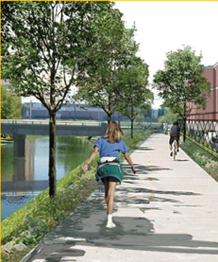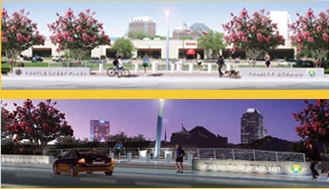NCTCOG relies on competitive calls for projects and other funding initiatives to determine which projects receive money.
NCTCOG and its partners select projects that advance regional priorities. Projects are evaluated based on their merits and impact on the transportation system. The selection criteria include cost effectiveness, congestion reduction and coordination with other modes of transportation. If projects will reduce congestion and help the region meet its air quality goals, they are given high priority. What's your role?As a resident, you can determine what projects are undertaken. If you see a need, let your city, local government or NCTCOG know so it can submit an application. Once the application is reviewed, the project could be awarded funds.
Your opinion is crucial to the process. NCTCOG requests comments at public meetings throughout the project selection, planning and construction phases. You may also talk with staff members from NCTCOG or the Texas Department of Transportation (TxDOT). How does a project begin?Transportation projects can take years to plan and construct. But every project begins with the same thing: a need.
In North Texas, intricate roads and rail lines complement each other, working together to get people where they need to go. But as the area continues to grow, commutes are becoming less reliable.
Other infrastructure improvements, such as bicycle/pedestrian paths, traffic signal timing, rail and intersection improvements are becoming more important as the region seeks to improve air quality and quality of life.
The catalyst for Dallas-Fort Worth transportation improvements is often traffic congestion or air quality concerns. Cities, counties, transportation partners and residents develop project ideas to meet transportation and air quality needs of everyone in North Texas. Who recommends projects?Once a need has been identified, it’s time to place the project in a long-term plan and secure funding.
Revenue can come from federal, state or local sources, depending on the project. As funds are made available, the Texas Department of Transportation and North Central Texas Council of Governments, through the Regional Transportation Council, decide where to spend the money.
As the region’s metropolitan planning organization, NCTCOG makes recommendations regarding surface transportation, congestion mitigation, air quality and federal transit projects.
TxDOT and NCTCOG work together to develop major transportation projects with federal and state funds. TxDOT and NCTCOG work with cities throughout the region to deliver local projects. Residents’ input is essential when seeking to improve the transportation system and is sought throughout the
decision-making process.  | Project spotlight
NCTCOG awarded the Trinity Strand Trail $5.67 million from the Regional Toll Revenue (RTR) funding initiative after the project scored well on a | | variety of criteria. Trinity Strand was evaluated along with other bicycle/pedestrian projects in the region and was awarded funds from the $3.2 billion State Highway 121 upfront payment. |
What happens next?Identifying funding is just the beginning. If federal or state money is involved, project sponsors must work with TxDOT or NCTCOG to secure the funding through project agreements.
Construction cannot start until the project has been engineered, environmentally reviewed and the necessary land has been purchased. Additional steps include securing appropriate permits, and relocation of water/sewer lines, cable, phone or electric utilities.
The construction contract is awarded through a competitive bidding process, and the winning bid is submitted to the appropriate local or state council or commission for approval. Now, construction can begin. The process can vary depending on the funding sources. How long does project development take?| Project Phases | Locally Funded Schedule | Federally/State Funded Schedule | | Engineering | 3 - 12 months | 3 - 12 months | | Environmental review | 0 - 6 months | 1 - 2 years | | Land purchase | 0 - 2 years | 1 - 3 years | Utilities Relocation
(out of roadway) | 6 - 12 months | 6 - 12 months | | Construction | 1 - 2 years | 1 - 4 years |
| | TOTAL | 2 - 6 years | 4 - 11 years |
Projects funded with state and federal money go through a rigorous development schedule and can take several years to implement. Projects can be expedited with local and regional funds. | | Trinity Strand Trail:
An example project for greater understanding of the process |  | | Regional planners determined the Trinity Strand Trail would benefit the community in numerous ways, making it a good recipient of RTR funds. The project is an improvement consistent with the long-range transportation plan and the goal of a regional network of bicycle and pedestrian trails. It also would provide a tangible air quality benefit. |

Click here for a PDF brochure version of this information.
If you would like more information or you have funding questions, contact us at transinfo@nctcog.org. |




